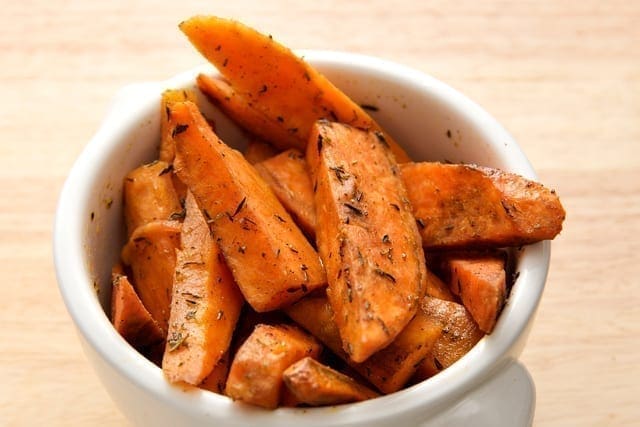By now, you’ve most likely heard of the glycemic index (GI). Maybe you’ve thought about trying a low GI diet in an effort to get back into your skinny jeans. Or maybe you’ve heard the name in passing, but still aren’t quite sure what it means and whether it’s just another gimmicky diet. Well. guess no more—we have the lowdown for you.
COLUMN: Which Weight-Loss Plan Is Your Best Bet?
Originally developed as a way to help diabetics manage their sugar intake, the glycemic index is a tool that measures how quickly a carbohydrate is digested and released as glucose (sugar) into the bloodstream. It works by assigning foods a number on a scale of zero to 100—the higher the number, the steeper the blood sugar response.
The theory behind this way of eating is that higher GI foods are digested quickly, causing a sugar spike, followed by that dreaded sugar crash—all of which leaves us in a vicious cycle of jonesing for more high GI foods (think: soda, white breads and chocolate cake) and being irritable in the process.
On the other hand, lower GI foods are broken down more slowly, releasing sugar at a steadier rate. As a result, you feel full and satisfied longer after you eat. And we all know what that means: reduced hunger and ultimately, a reduced waistline. Bring on the low GI foods, please!So who should be following the glycemic index? Everyone, according to Kristin Kirkpatrick, R.D., YouBeauty Nutrition Expert, because it’s not really a diet. It’s a way of life.
“A lot of people think, I don’t have diabetes, so I don’t need that, but if you look at what consistently raising our blood sugar does to our health, you’ll change your mind,” notes Kirkpatrick. “Blood sugar is responsible for inflammation, weight control, heart disease and metabolic syndrome, so this is something that should be adapted into your lifestyle and something you should pay attention to, regardless of whether you’re diabetic or not.
”So how do you know what to look for? Many packaged food products list the glycemic index on their labels, although it’s not required. Here’s the general rule of thumb when it comes to interpreting those numbers:
- Low (good) glycemic index levels: 55 or less
- Medium glycemic index levels: 56 to 69
- High (bad) glycemic index levels: 70 or higher
READ MORE: Three Delicious Low-Glycemic Breakfasts
It’s no surprise that high glycemic index foods include many simple carbohydrates, such as donuts, soda, baked goods and any white starches such as bread, pasta and rice. “Basically, anything that’s like a cookie or candy and anything where the first or second ingredient is sugar,” explains Kirkpatrick.
On the flip side, low glycemic index foods include whole foods that tend to fill you up and keep you satisfied, such as whole wheat, beans, lentils, sweet potatoes, non-starchy vegetables and anything that’s a protein or dairy product. It’s all about low-processed foods.But before you head off to the grocery aisles in search of low GI foods, you should know that the glycemic index is a start when it comes to assessing how your body and blood sugar will respond to certain foods, but it’s not a hard and fast rule of which foods to chow down on and which ones to ditch.Here’s why: Some healthy foods can have a high GI score, such as watermelon, which is a 72. A better way to look at it, explains Elizabeth Somer, R.D., author of “Eat Your Way to Sexy: Reignite Your Passion, Look Ten Years Younger, and Feel Happier Than Ever,” is by looking at the “glycemic load,” which compares a food’s GI score with the amount of calories and carbs it contains.“The glycemic load is a much better indicator of a food’s ability to prevent or contribute to disease, since a food that has a large amount of carbs and dramatically raises blood sugar levels obviously increases the chances of weight gain more than a food that might temporarily raise blood sugar levels, but has few calories,” explains Somer.
COLUMN: Five Healthy Snacks Under 150 Calories
For example, a potato has a high glycemic score and packs a bunch of carbs, while watermelon also has a high GI score, but few calories or carbs. “The former will increase the chances of those extra calories being funneled into fat cells,” says Somer, “but watermelon just fills you up, without filling you out. Ever hear of anyone getting fat on watermelon?”
Rather than stressing about each food’s GI score and adding yet another number to obsess over, Somer suggests keep it simple when heading to the store. “A simple guideline for eating in tune with your blood sugar and waistline is to choose lots of wholesome, natural foods, such as watermelon and other fruits and vegetables, whole grains, nuts, legumes and seafood, which automatically will lower your overall GI score and keep you healthy throughout life.”
And regardless of where foods may fall on the glycemic index, being mindful of your portion sizes still applies, especially if you’re trying to lose weight.
“When you look at fat loss, anything that you eat too much of and doesn’t get burned gets stored as fat,” adds Kirkpatrick. “Even though low GI foods are better, you can’t just eat them all day. It’s still all about portion control.”




































